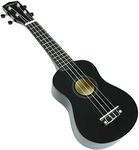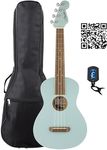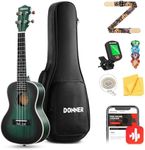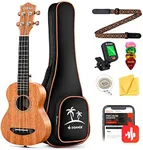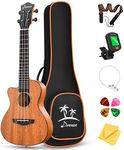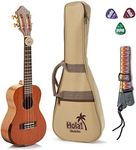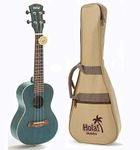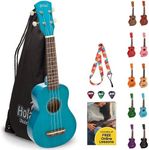Buying Guide for the Best Ukuleles
Choosing the right ukulele can be a delightful experience if you know what to look for. Ukuleles come in various sizes, materials, and designs, each offering a unique sound and playing experience. Understanding the key specifications will help you find the perfect ukulele that matches your needs and preferences. Whether you're a beginner or an experienced player, considering these factors will ensure you make an informed decision and enjoy your musical journey.SizeUkuleles come in four main sizes: soprano, concert, tenor, and baritone. The size affects the instrument's sound, playability, and portability. Soprano ukuleles are the smallest and produce a bright, traditional sound, making them ideal for beginners and children. Concert ukuleles are slightly larger, offering a fuller sound and more finger space, suitable for players with larger hands. Tenor ukuleles provide an even deeper tone and more room on the fretboard, favored by intermediate and advanced players. Baritone ukuleles are the largest, with a rich, guitar-like sound, perfect for those who prefer a deeper tone and are comfortable with a larger instrument. Choose the size based on your comfort, hand size, and the sound you prefer.
MaterialThe material of a ukulele significantly influences its sound quality and durability. Ukuleles are typically made from wood, with common options including mahogany, koa, spruce, and laminate. Mahogany offers a warm, balanced tone and is durable, making it a popular choice for beginners. Koa, a Hawaiian wood, produces a bright, rich sound and is often used in high-end ukuleles. Spruce provides a clear, loud tone, suitable for players who want a more pronounced sound. Laminate ukuleles are made from layers of wood and are more affordable and resistant to changes in humidity, but they may not sound as rich as solid wood. Consider the material based on your sound preference, budget, and the environment where you'll be playing.
StringsUkulele strings are typically made from nylon or fluorocarbon, each offering different playing experiences and sound qualities. Nylon strings are softer on the fingers and produce a mellow, warm tone, making them ideal for beginners. Fluorocarbon strings are more durable, hold their tuning better, and produce a brighter, louder sound, preferred by more experienced players. Some ukuleles come with wound strings, which have a metal winding and offer a different texture and sound, often used for the lower notes on tenor and baritone ukuleles. Choose strings based on your playing style, comfort, and the sound you want to achieve.
TuningUkuleles are typically tuned to G-C-E-A, but baritone ukuleles are tuned to D-G-B-E, similar to the highest four strings of a guitar. The tuning affects the instrument's sound and the chords you play. Standard G-C-E-A tuning is great for traditional ukulele music and is easier for beginners to learn. D-G-B-E tuning on baritone ukuleles offers a deeper sound and is suitable for players transitioning from guitar. Consider the tuning based on your musical background and the type of music you want to play.
Build QualityThe build quality of a ukulele affects its playability, sound, and longevity. Look for a ukulele with a well-constructed body, smooth fretboard, and properly aligned frets. The neck should be straight, and the action (the distance between the strings and the fretboard) should be comfortable for playing. High-quality ukuleles often have better craftsmanship, resulting in a more enjoyable playing experience and better sound. Inspect the ukulele for any visible defects or rough edges. Choose a ukulele with good build quality to ensure it lasts longer and provides a better playing experience.
Brand ReputationThe reputation of the brand can be an indicator of the quality and reliability of a ukulele. Established brands often have a history of producing well-crafted instruments and providing good customer support. Researching reviews and recommendations from other players can help you identify reputable brands. While brand reputation is not the only factor to consider, it can give you confidence in your purchase. Choose a ukulele from a brand known for its quality and customer satisfaction to ensure you get a reliable instrument.




